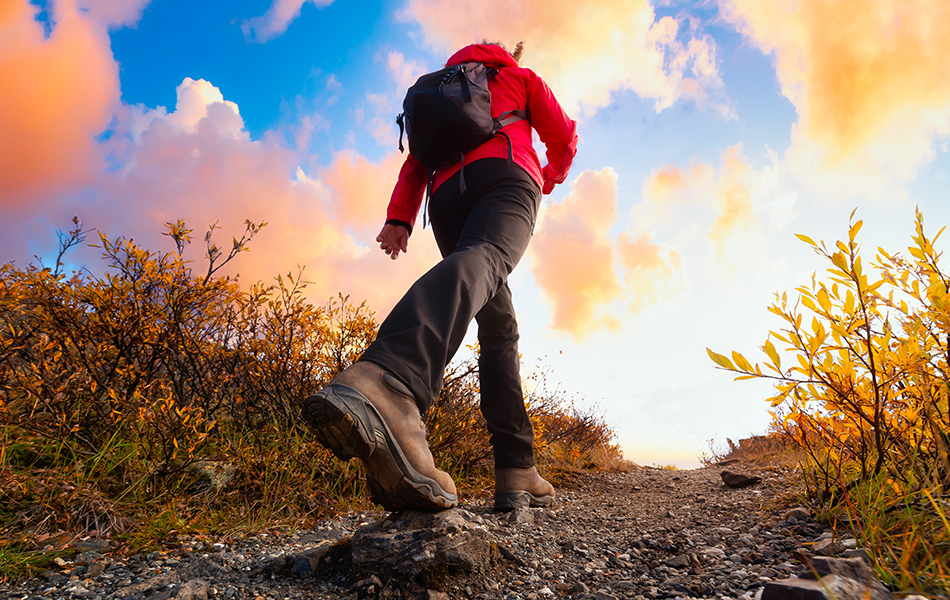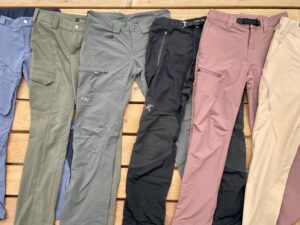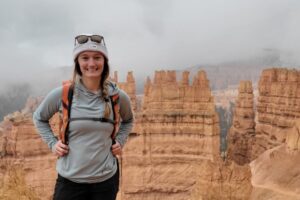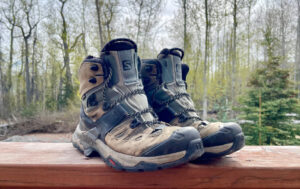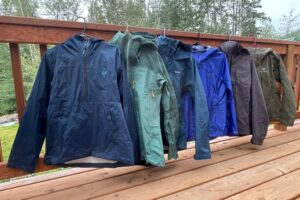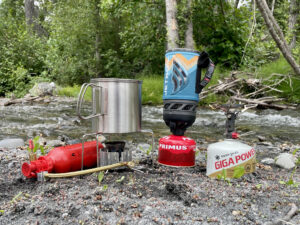Hiking pants are a critical piece of outdoor gear that protects our legs and helps us regulate our temperature in both hot and cold weather. Finding the right pair of hiking pants for you isn’t always easy, however.
The ExplorersWeb team tested over a dozen pairs of hiking pants to create this guide. We looked for pants that were both breathable and protective from the sun and rain, and didn’t restrict our movement.
Gear Editor Chelsey Cook routinely spends several consecutive weeks wearing a single pair of hiking pants on expeditions and knows the value of comfortable, durable pants that you don’t mind living in. She put several of our favorite pairs through the wringer, wearing them on backpacking and packrafting trips in the Alaskan bush, testing them on the volcanoes of Washington, and relying on them to protect her legs from abrasions on canyoneering trips in Utah.
There’s no one-size-fits-all when it comes to hiking pants, so we tested a range of pants, from full-length to convertible to hiking tights. The pants in this guide have a variety of different features, including water-repellent finishes, added sun protection, cargo and zipped pockets, integrated belt systems, and ankle cuffs. Most of the pants in this guide are available in both men’s and women’s sizes.
If you’re looking for the right footwear to pair with your hiking pants, check out our guide to the Best Hiking Boots.
Editor’s Note: We updated this guide on May 15, 2024, to announce the Best Overall Hiking Pants as the Arcteryx Gamma Pants after two years of additional testing, and added superlatives for Best Lightweight Hiking Pants and Most Versatile Hiking Pants. We also added Best All-Around Men’s and Women’s Pants for the pairs we love to wear hiking and in our daily lives.
Our Picks for the Best Hiking Pants of 2024
- Best Overall Hiking Pants: Arcteryx Gamma Pants
- Best All-Around Women’s Hiking Pants: 5.11 Shella Pants
- Best All-Around Men’s Hiking Pants: Prana Stretch Zion Pants
- Most Versatile Hiking Pants: Norrona Falketind Flex1 Pant
- Best Lightweight Hiking Pants: Arcteryx Gamma Lightweight Pants
- Best Hiking Pants for Scrambling: Outdoor Research Ferrosi Pants
- Best Convertible Zip-Off Hiking Pants: Columbia Silver Ridge Pants
- Best Hiking Leggings: Icebreaker Merino 260 Fastray High Rise Tights
Best Overall Hiking Pants:
Arcteryx Gamma Pants
Features: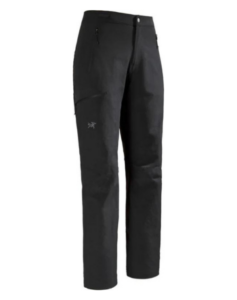
- Laminated cuffs and adjustable pant cuff drawcord
- Gusseted crotch for easy movement
- Three zippered pockets for safe storage
- Thigh pocket sits below a climbing harness
- Low profile belt doesn’t rub under a pack or harness
Why we like it: Comfortable softshell pants for hiking, climbing, or mountaineering
What we don’t like: Heavier fabric may not be suitable for hot conditions
Fabric: 88% nylon, 12% elastane | Water Resistant: Yes | UPF: No | Men’s or Women’s: Both
The Arcteryx Gamma Pants ($200), available in men’s and women’s, are our choice for the best overall hiking pants. They’ve been Chelsey’s go-to pants for backpacking and hiking in Alaska, as well as summer mountaineering and alpine climbing trips in Washington. She loves how stretchy they are, with a gusseted crotch and articulated knee. The waistband and integrated belt are slim and have a soft inner liner, increasing comfort when carrying a heavy backpack. All the pockets are zippered, a must for Chelsey, who likes to store small items in her pockets for easy, on-the-go access. While they aren’t 100% waterproof, the DWR finish is one of the best we’ve seen, and the pants dry quickly.
Check Women’s Price at Arcteryx
Best All-Around Women’s Hiking Pants:
5.11 Shella Pants

Features:
- Minimalist design for daily wear
- Reinforced belt loops
- Six total pockets, including large cargo pockets
- DWR finish
- Reinforced belt loops
- Extremely comfortable
Why we like it: Minimalist, casual enough for daily wear, very comfortable waistband
What we don’t like: No integrated belt or adjustable cuffs, only zipped back pockets
Fabric: 89% polyester, 11% elastane | Water Resistant: Yes | UPF: No | Men’s or Women’s: Women’s
The 5.11 Shella Pants ($68) are Chelsey’s favorite hiking pants for daily wear, long travel days, and day hikes. The stretchy, DWR-treated fabric is ideal for hiking, while the functionally minimalist look doesn’t look out of place for casual wear. Kirby and Chelsey thought they were one of the most comfortable pairs of pants they tested. They have two hand pockets, two zippered back pockets, and two cargo pockets, providing ample storage. Additionally, the belt loops are reinforced, so you can hang small items off them with a carabiner if needed. The waistband is also wider than many other women’s pants and doesn’t cut into our stomachs when sitting, squatting, or bending over.
Best All-Around Men’s Hiking Pants:
Prana Stretch Zion Pants
Features: 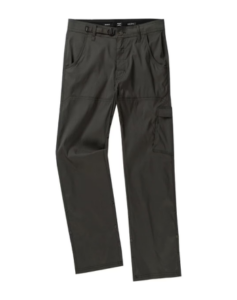
- Recycled fabric, Fair Trade, and bluesign® certified
- UPF 50+ for sun protection
- Casual enough for everyday wear
- PFAS-free water-repellent finish
- Adjustable webbing waistbelt
- Double-entry cargo pockets
Why we like it: Comfortable, sustainable pants that look at home at the trailhead or at the brewery
What we don’t like: Not very breathable, few zippered pockets
Fabric: 95% recycled nylon, 5% elastane | Water Resistant: Yes | UPF: 50+ | Men’s or Women’s: Men’s
The Prana Stretch Zion Pants ($95) are our male testers’ pick for the best all-around men’s hiking pants. As it says in the name, these pants are super stretchy and one of our testers uses them for both rock climbing and hiking, as well as for going to yoga classes. At first glance, the Stretch Zion pants look like an everyday pair of pants, perfect for a day in town or even the office on more casual days. The Zion Pants have a double-zippered cargo pocket for safe storage, a low-profile adjustable waistbelt, and snap buttons to secure rolled-up pants legs. The fabric does feel heavier than other pants and can be a little too warm on hot summer days.
Most Versatile Hiking Pants:
Norrona Falketind Flex1 Pant
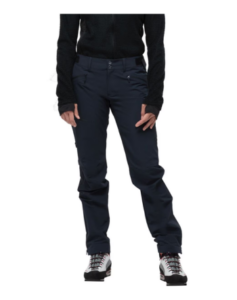
Features:
- Made with sustainable and eco-friendly materials
- PFC-free DWR finish
- Multiple pockets
- Reinforced knees and seat
- Adjustable lower leg
- Made with recycled materials
Why we like it: Breathable, stretchy, do-it-all pants
What we don’t like: Not enough wind resistance for cold conditions
Fabric: 69% recycled polyamide, 19% recycled polyester, 12% elastane | Water Resistant: Yes | UPF: No | Men’s or Women’s: Both
The Norrona Falketind Flex1 Pants ($199) were our choice for the most versatile pants and one of Kirby’s, one of our testers, favorite products thanks to their durability, versatility, and features. Kirby wore them on several hikes and off-trail scouting missions, and while bouldering and rock climbing. The slim fit was comfortable and attractive, and the pants moved well with her. She particularly enjoyed features such as a zippered thigh pocket, a custom-fit waist system that uses velcro, reinforced knees and seat, and an adjustable lower leg with a zipper and a gusset to let your legs breathe.
The Falketind Flex1 Pants are eco-friendly, with bluesign® certified fabric made from recycled fibers, and a PFC-free DWR finish. They come in men’s and women’s models.
Check Women’s Price at Backcountry
Best Lightweight Hiking Pants:
Arcteryx Gamma Lightweight Pants
Features: 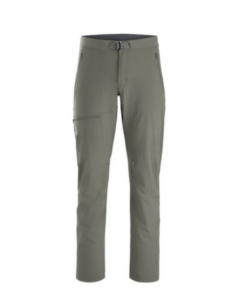
- Made from recycled materials
- Low profile belt doesn’t rub under a pack or harness
- Three zippered pockets
- UPF rating of 40+ for sun protection
- High elastane percentage for stretch
- Lightweight fabric that balances breathability with wind resistance
Why we like it: All of the best features of the Gamma Pants in incredibly lightweight, breathable material
What we don’t like: Thinner fabric may be less abrasion-resistant
Fabric: 86% nylon, 12% elastane | Water Resistant: Yes | UPF: 40+ | Men’s or Women’s: Both
The Arcteryx Gamma Lightweight Pants ($160) have all of the best features of the Gamma Pants, our best overall pick, in a lighter, more breathable fabric. Chelsey has used the women’s version of the Gamma Lightweight Pants for years for her spring and fall backpacking and canyoneering trips in Utah. She likes the flexibility of the four-way stretch fabric and how lightweight the pants feel in hotter temperatures. They also have three zippered pockets for storing valuables and, despite being so lightweight, have adequate wind- and water resistance, as well as UPF 40+ to protect you from the sun’s rays.
She’s found that the pants are more prone to abrasion than the Gamma Pants, though any pants would be hard-pressed to stand up to repeated seasons of slithering through Utah’s slot canyons. They also come in men’s sizes.
Check Women’s Price at Arcteryx
Best Hiking Pants for Scrambling:
Outdoor Research Ferrosi Pants

Features:
- Stretchy fabric for freedom of movement
- Abrasion resistant fabric
- Harness compatible waist
- Made from bluesign® recycled nylon
- UPF 50+ for sun protection
- Relaxed fit
- Zip pockets
Why we like it: Soft and abrasion-resistant with plenty of stretch
What we don’t like: Material is prone to pilling
Fabric: 46% recycled nylon, 40% nylon, 14% spandex | Water Resistant: Yes | UPF: 50+ | Men’s or Women’s: Both
The Outdoor Research Ferrosi Pants ($99) are made from OR’s famous Ferrosi fabric, one of Chelsey’s favorite softshell fabrics because of its softness and stretchiness. She wears these pants during alpine scrambles and rock climbs, where durability and freedom of movement are key. They offer a relaxed fit and good wind and water resistance. Some features we love are the zippered thigh pocket that is accessible when wearing a harness, the articulated knees, and the adjustable ankle cuffs, which help keep out debris. There’s also an internal drawcord waist to refine the fit, and the pants are rated to UPF 50+ to protect your legs from the sun.
The Outdoor Research Ferrosi Pants are available in men’s and women’s sizes.
Best Convertible Zip-Off Hiking Pants:
Columbia Silver Ridge Hiking Pants

- Durable 100% nylon construction
- Converts to shorts with easy zip-off legs
- UPF 50 fabric offers UV protection
- Omni-Wick™ technology pulls moisture to the fabric’s surface to evaporate
- Mesh pocket bags increase airflow
- Partial elastic waist for comfort
Why we like it: Breathable, lightweight fabric that wicks sweat
What we don’t like: No water-resistant finish
Fabric: 100% nylon | Water Resistant: No | UPF: 50 | Men’s or Women’s: Both
In our opinion, the Columbia Silver Ridge Hiking Pants ($65) are some of the best-looking convertible pants and they’re as comfortable and functional as they are attractive. These pants are perfect for hot, dry hiking adventures. They’re lightweight wonders, with UPF 50 protection from the sun and an Omni-Wick™ technology that pulls moisture to the fabric’s surface to evaporate in warm weather. Most importantly, they easily convert into shorts with zip-off legs. We love the integrated belt and the breathability that a gusseted crotch offers. These convertible pants are surprisingly effective against the wind and offer pockets with flaps and zippers to hold small items, including a cargo pocket for your phone.
The Silver Ridge Hiking Pants are also a great option for budget hiking pants, with plenty of features at a low price. They’re available in a women’s utility version as well.
Check Men’s Price at Backcountry
Check Women’s Price at Backcountry
Best Hiking Leggings:
Icebreaker Merino 260 Fastray High Rise Tights

Features:
- 97% merino wool
- Stash pocket large enough for a phone
- High-rise waist
- Body contouring details
- Flatlock seams to prevent friction
Why we like it: Comfortable high waist, stash pocket for phones
What we don’t like: Not water or wind-resistant, expensive
Fabric: 97% merino wool, 3% elastane | Water Resistant: No | UPF: No | Men’s or Women’s: Women’s
Leggings are a popular choice for hiking because they are stretchy and can pull double duty at yoga, the gym, or layered under hiking pants during colder seasons. The IceBreaker Fastray High Rise Tights ($120) are Kirby’s favorite hiking tights. She likes the insulation the merino wool provides and how easy it is to move in them. The high waist also gives them a form-hugging and flattering fit, and there’s a gusseted crotch for increased mobility and airflow. While most leggings don’t have pockets, these feature a thigh stash pocket large enough for a phone. Like most leggings, these are not water or wind resistant.
Icebreaker also offers men’s hiking tights.
Check Women’s Price at Icebreaker
Honorable Mentions:
Prana&subId2=explorersweb Halle Pants

Features:
- Trouser-like pants for both active or casual wear
- Option to roll up pants and secure with a button closure
- Stretch Zion fabric
- Five total pockets
- DWR finish
- Women’s only
Our first runner-up is the Prana Halle Pants, which Kirby and Chelsey tested while hiking, backpacking, and climbing. They liked the durability, the pockets, and the option to roll up the pants legs and secure them. However, Chelsey found that the pants stretched out a lot over a few days of wear, making for a baggy fit on backpacking trips. There’s also no integrated belt, and having to wear a belt with them makes them less ideal for carrying heavy backpacks.
While there are no men’s Halle Pants, the Prana Stretch Zion are comparable.
5.11 Meridian Pants

Features:
- Front pockets, back pockets, and cargo pockets
- Vents for breathability
- Hand-washing required
- Extremely durable
- Articulated knees
- Slim-fit
- Men’s only
The 5.11 Meridian Pants are a slim-fit pair of pants that are a great choice for climbing, scrambling, or hiking. Our tester wore these pants for an alpine rock climb that required a brutal 4.5-hour hike on both ends. In total, he spent 30 hours straight in these pants, and he liked the slim fit that still allowed him to bend and stretch, the venting, and the numerous pockets.
The downside is that the fabric dye requires hand-washing.
Buck Mason Trail Roam Pants

- Cotton and nylon construction with a DWR finish
- Elastic waist with drawcord closure
- Great for relaxed hiking days
- Four total pockets
- Loose fit
- Men’s only
The Buck Mason Trail Roam Pants ($118) feature a cotton nylon blend with a DWR coating. The back pockets close with buttons and there are two hand pockets on the front. The waist is elastic with drawcord tightening.
The hips are baggy, and our tester wasn’t thrilled with the overall fit of the pants. While the loose fit is good for ventilation and comfort, it felt a little sloppy and wouldn’t be ideal for technical hiking or scrambling where the pants leg could catch on things.
Check Men’s Price at Buck Mason
About our testing process
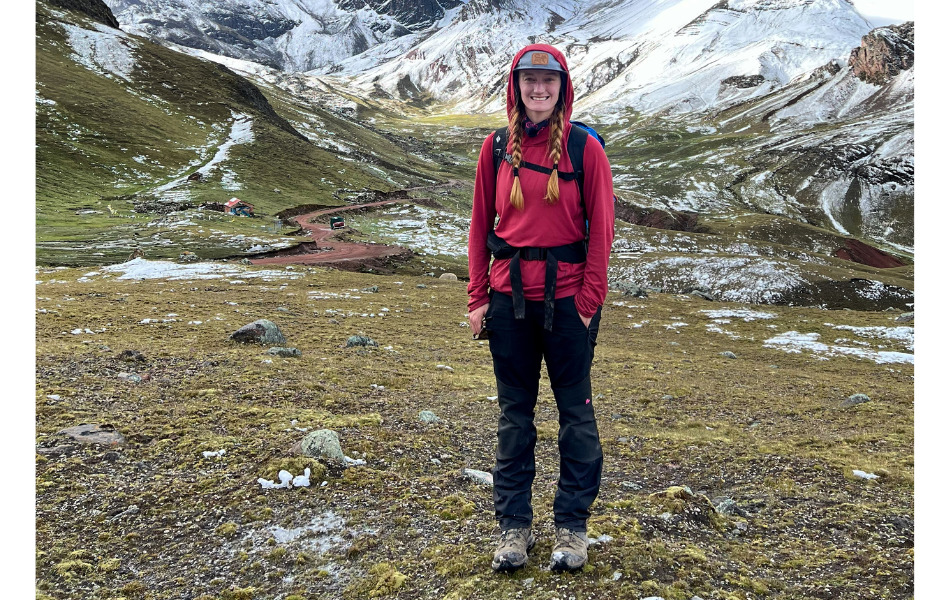
Testing hiking pants in the Ausangate region of Peru. Photo: Chelsey Cook
The ExplorersWeb team has tested over a dozen different hiking pants, racking up countless hours and miles of hiking and backpacking around the world in our search for the best pair.
Kirby Kahl started this guide in October 2022 and has been hiking for her entire life. She’s well-versed in technical apparel and looks for hiking pants that can do it all. She and her partner tested most of the pants selected in this guide and wore them on hiking trips and long alpine climbs. Kirby also looked in the closets of her broad network of climbing, hiking, and backpacking friends, and their experiences and opinions on hiking pants helped shape this guide.
Gear Editor Chelsey Cook took over the guide in May 2024. She has over twenty years of experience hiking, backpacking, and mountaineering. She tested the pants in this guide on day hikes, backpacking trips, and longer expeditions in Alaska, Washington, Utah, Scotland, Peru, and the Faroe Islands. Chelsey also incorporated several pairs into her daily wear in Alaska, to see how their comfort and style stood up in the front country.
When testing the durability of hiking pants, we wore them as much as possible. Chelsey took a few of our favorite pairs canyoneering in Utah, and squeezing through slot canyons and stemming rough canyon walls quickly separated out which pants could stand up to some abuse. When testing the comfort and stretchiness of hiking pants, we wore them scrambling and rock climbing and looked for the pants that hindered us the least. We also tested hiking pants in a range of different conditions, from wet, cold, and snowy to hot and dry, and evaluated each pair for their breathability and wind- and water resistance.
We looked for hiking pants with different fits, from relaxed to slim, as well as budget pants, lightweight and heavier pants, pants with rain and sun protection, and pants with features like roll-up and zip-off legs. This guide will continue to grow and change as we test new hiking pants.
Things to consider when buying hiking pants
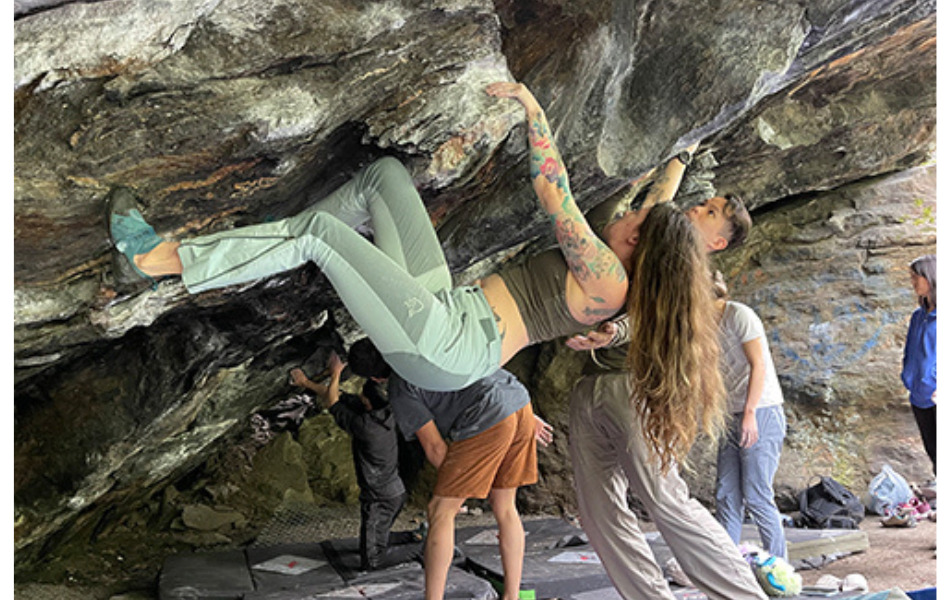
Testing the stretchiness of Norrona’s hiking pants. Photo: Kirby Kahl
Types of hiking pants
Hiking pants come in a variety of different types, including traditional, convertible, roll-up, and tights. Traditional pants are typically full-length and water-resistant. These are a versatile option for most hiking needs, as the DWR finish will keep you warm and dry during bad weather while the full-length legs will protect you from the sun and any bushwhacking.
Convertible hiking pants have zip-off legs that turn the pants into shorts. This gives you more options on long hikes when the weather might warm significantly. However, they can look a little strange and you have to remove your hiking boots to pull the legs off. Roll-up pants are a happy medium between traditional and convertible pants. They have a button or drawcord that secures the pant cuff when you roll them up.
There are also hiking tights, like the IceBreaker Fastray High Rise Tights. Some people may find tights more comfortable than hiking pants. However, they don’t offer any weather protection and snag easily on rocks and branches.
Materials
Most of the hiking pants in this guide and on the market are made of a mix of polyester or nylon and an elastic fiber like elastane. Polyester and nylon are both durable fibers, while elastane gives hiking pants some stretch. Coupled with a water-repellent finish, this fabric is often called ‘soft-shell’, and is both breathable and protective.
Cotton blends are also occasionally used in hiking pants. Cotton is very breathable, however, it absorbs moisture and isn’t insulating when wet. Cotton pants should be reserved only for hot, dry climates.
Hiking tights are generally made of the same materials as hiking pants, though some feature merino wool, which wicks away moisture, prevents odor buildup, and will keep you warm even when wet.
Weather protection
Hiking pants, particularly soft-shell ones, often have a durable water-repellent finish (DWR). A DWR coating doesn’t necessarily mean waterproof, but it does add enough water resistance to keep you dry when hiking in light rain or through wet foliage. It does breathability, however, and water resistant pants often feel heavier. DWR treatments have also historically used PFAS chemicals, which are now thought to pose long-term risks to the environment and our health. Many outdoor brands are now moving towards PFAS-free DWR treatments.
Some hiking pants, like the Prana Stretch Zion Pants and the Arcteryx Gamma Lightweight Pants, have a UPF, or ultraviolet protection factor, rating, which measures how well the fabric blocks harmful UV radiation from the sun. The higher the UPF rating, the more UV radiation the fabric blocks. If you hike in the desert or at high altitudes, consider hiking pants with a high UPF for added protection.
Mobility and fit
Hiking pants should move with you. If you usually hike well-groomed trails, you may not need the stretchiest hiking pants on the market. However, if you plan on scrambling or climbing in your pants. you’ll want pants with a higher percentage of stretchy materials like elastane. Features like a gusseted crotch and articulated knees also improve the range of motion.
Hiking pants come in a variety of fits. Slim fits may restrict motion, while baggier fits could snag on rocks and undergrowth. Because everyone is shaped differently, it’s best to try on several different pairs of hiking pants before settling on one you like. You want your pants to fit snuggly, but not restrict your movement. If you’ll be carrying a heavy backpack, look for hiking pants that don’t require you to wear a belt, as a belt can rub against a pack and your skin.
Additional features
Hiking pants run the gamut from fully featured to minimalist when it comes to design. Ideally, you want a pair of pants to have all the features you find necessary, without adding weight or restricting movement. If you like carrying things in your pockets, look for pants with a mix of large cargo pockets and zipped pockets for extra protection. Integrated belts can also be a nice option, but make sure the system is comfortable and stays in place on your body. Some pants come with adjustable cuffs, which can be helpful if you wear a variety of different shoes and boots when hiking.
Frequently asked questions about hiking pants
What types of pants are best for hiking?
The type of hiking pants that works best for you depends on where you hike, what weather you hike in, the duration of your hiking trips, and your personal preferences. If you hike in cold, wet conditions, look for pants with a DWR finish. If you prefer to hike in the desert or hot conditions, look for lighter fabrics with a UPF rating, convertible pants, or roll-up pants. Above all, make sure your hiking pants fit you well and don’t restrict your movement.
Should hiking pants be loose or tight?
Hiking pants should be comfortable and not impede your movement. They should neither be too tight nor too loose. Here’s how you can test your pants before you venture onto the trail with them.
Squat – Your pants shouldn’t be pinching you anywhere when squatting, or riding up more than a few inches. The waist should still be flush against your back.
Sit – If the pants are tight or uncomfortable when sitting, you may need another size or another design.
Raise one knee at a time – Raise each knee as high as possible. Your pants shouldn’t block your movement, pinch at your hips, split at the crotch, or ride up more than a few inches.
Do I need to wear long pants when hiking?
This is a personal preference. We generally wear full-length hiking pants because they not only protect us from the sun and rain but also from mosquitoes and abrasions from rocks or undergrowth. If you’re hiking in the desert, however, you may appreciate the breathability of shorts. A convertible pair of pants is a good way to have all of your bases covered.
Can I hike in jeans?
Jeans are not a great option for hiking. They’re made of cotton, which doesn’t wick away moisture or insulate when wet. They’re also not breathable, don’t stretch, and are heavy compared to hiking pants.
What shoes should I wear with hiking pants?
You should wear sturdy shoes that offer your feet support and protection, as well as traction on a variety of terrain. Check out our Best Hiking Boots of 2024 for a full guide.
